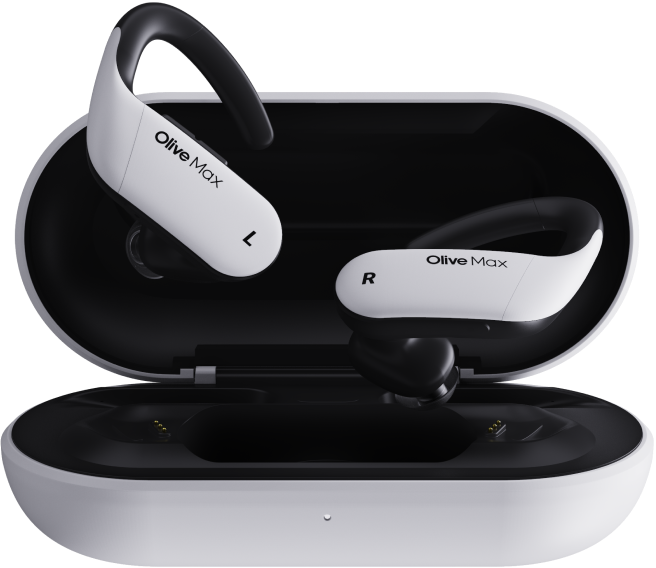
A popular option for their small size and discreetness, open fit hearing aids are a kind of hearing aid that compromise of “…an ear canal tube sized for positioning in an ear canal of a user so that the ear canal is at least partially open for directly receiving ambient sounds.”
How Does an Open Fit Hearing Aid Work?
Open fit hearing aids operate along the same fundamental principles as most other aids, consisting of a receiver (or microphone), amplifier, and speaker. Sound is picked up and transmitted through the amplifier as tiny electrical signals, which are amplified and finally converted back into sound and sent to the ear through the speaker.
The specific difference that sets open fit hearing aids apart is their relatively petite bud-like speaker component. Instead of being stored in the hearing aid device along with the receiver and amplifier, the speaker bud is placed inside the ear canal, where it takes up a small cross section – hence “open fit”.
This usually helps to prevent something called the ‘occlusion effect’ (more on this later) and, for those with comparatively better hearing, can allow a blend of natural and aid-assister hearing for louder sounds.
Open fit hearing aids are usually very discreet. They’re battery-powered, but generally, the aid’s power pack and microphone are quite small and can be tucked discreetly behind the back of the ear itself, with only a thin, clear tube or wire looping down into the auditory meatus (your ear canal).
Their smaller size means that unfortunately they are not strong enough for sever or profound hearing loss, however. For those with mild to moderate hearing loss, however, they should be just fine.
What Are They Good For?

Attractive to many is their subtlety — aside from very small in-ear hearing aids, they’re probably the most discreet aids on the market. Wearers of older-model larger aids who feel conscious of their size and visibility might want to take a look.
Open fit hearing aids are also widely regarded as a comfortable option. This is because their soft plastic or foam bud sits only a short way into the ear canal, and doesn’t completely block it in the process — contrast this with hearing aids with a molded earpiece (or ‘earmold’ ), which can often make the wearer feel plugged-up or cause discomfort over a long period of use. The effect of an open fit aid’s bud is a little like wearing earphones rather than earplugs.
Another plus for open fit hearing aids is the speed with which they can be fitted. Because the aid does not usually need to be precision-molded to the ear, it’s not unusual to leave an audiologist after only a short appointment with a new pair of open fit aids to try. Again, contrast this with mold-fitted aids, which usually take a fitting and a subsequent wait afterward for your molds to arrive.
The uniquely natural sound open-fir hearing aids can deliver is another strong selling point. As a result of the in-ear components’ slim and non-occluding profile, sound is free to enter the ear canal naturally. This means wearers with only mild to moderate hearing loss can still hear many sounds both part-with and part-without assistive amplification, giving a very natural auditory experience.
Finally, and perhaps most importantly for some hearing aid-users, open fit hearing aids prevent the occlusion effect, which is often experienced when a hearing aid completely blocks the ear canal. When sound can’t escape out of a blocked ear canal, it reverberates around our ears instead, making breathing, chewing, speaking, and even taking footsteps sound hollow, loud, and quite unpleasant.
What What Are They Bad For?
Open fit hearing aids are generally regarded as having few downsides on the whole.
However, for some, they won’t be subtle enough. These people may wish to explore the IIC (invisible in canal) style, or speak to their audiologist.
Others with extremely severe hearing loss may find other, more powerful aids to their advantage, while some people might just prefer using a hearing mold.
For some, the cost may be an issue, but this depends on your level of coverage and open fit hearing aids are available at a variety of price points.
How To Care For An Open Fit Hearing Aid
![]()
One of the most common issues for hearing aid users is clogging — where earwax, cosmetics, or moisture get into the aid’s insides, blocking sounds or interfering with its circuitry. Each week, you should try to clean your hearing aid’s tubes by gently removing them following your device’s maintenance instructions, and cleaning them using the proper tools.
The speaker tip (or bud) which sits inside your ear should be replaced if it becomes bent out of shape, too loose, or clogged up with material. Even if this doesn’t appear to be the case, you might notice an improvement in your hearing if you swap in a new tip after forgetting to replace it for a while. Open fit hearing aids in particular are susceptible to earwax, due to the speaker resting inside the ear canal.
Hearing aids often require occasional adjustment and professional check-ups as a matter of course, but commonly experiencing ear infections or pain is a sure-fire sign something isn’t quite right.
If more serious problems arise, you should see your audiologist.
The UK’s Nottingham University has a helpful set of videos for open fit hearing aid users, available online here.
The information in this guide has been written using the following reliable sources:
https://newtonhearing.com, https://www.hearingreview.com, https://www.ncbi.nlm.nih.gov, https://www.which.co.uk, https://www.hearingaidknow.com, https://www.bootshearingcare.com, https://c2hearonline.com









